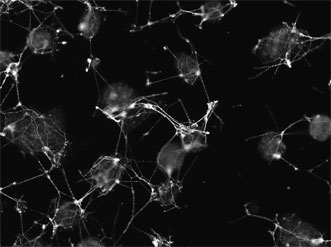Blue light can trigger the transformation of embryonic stem cells into neurons.
Based on optogenetics techniques, the discovery could be a first step toward complex tissue engineering using light, according to researchers at the University of California, San Francisco.
"There's lots of promise that we can do these miraculous things like tissue repair or even growing new organs," said faculty fellow Matthew Thomson, "but in practice, manipulating stem cells has been notoriously noisy, inefficient and difficult to control.
"I think it's because the cell is not a puppet. It's an agent that is constantly interpreting information, like a brain. If we want to precisely manipulate cell fate, we have to understand the information-processing mechanisms in the cell that control how it responds to the things we're trying to do to it."

Sustained exposure to blue light caused embryonic stems cells to transform into neurons and form neural networks. Courtesy of the University of California, San Francisco.
Thomson and colleagues caused cultured mouse embryonic stem cells to differentiate into neurons by activating the Brn2 gene with constant, 24-hour illumination at 300 μW. The cells reacted to intermittent illumination but did not differentiate.
Mediating the process is the protein transcription factor Nanog, to which the researchers added fluorescent tags using the CRISPR-Cas9 gene editing system.
When the Brn2 gene is activated by an external cue like the light, Nanog levels begin to drop. If the signal is sustained, the protein will eventually dissipate completely and the cell will begin its transformation. But if the signal is interrupted, Nanog levels quickly rebound, and the cell will do nothing.
The researchers described this process as an "internal timer" that lets stem cells tune out extraneous biological noise and act only when they detect a consistent, appropriate molecular signal.
"We've discovered a basic mechanism the cell uses to decide whether to pay attention to a developmental cue or to ignore it," Thomson said.
Thomson believes that similar mechanisms may govern stem cell differentiation into many different tissues. Someday, he said, the light-activation technique could be refined to involve a pattern of different colors illuminating a bath of undifferentiated stem cells to produce complete organs that could be transplanted into patients.
Funding came from the National Institute of General Medical Sciences, National Institutes of Health, National Cancer Institute, and National Institute of Dental and Craniofacial Research.
The research was published in Cell Systems (doi: 10.1016/j.cels.2015.08.001).